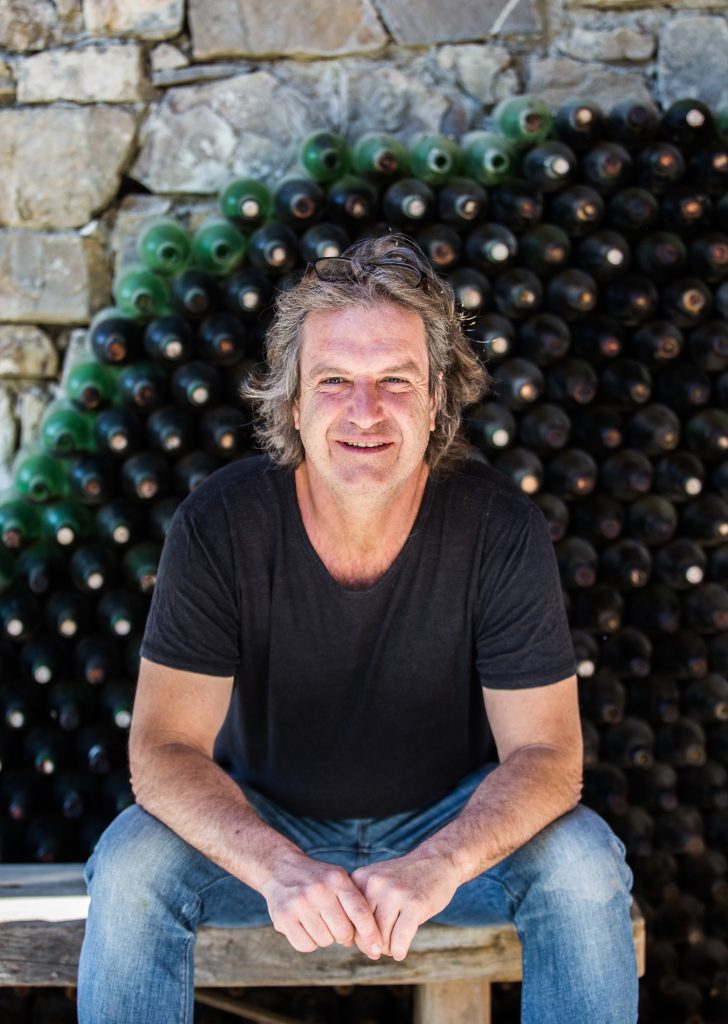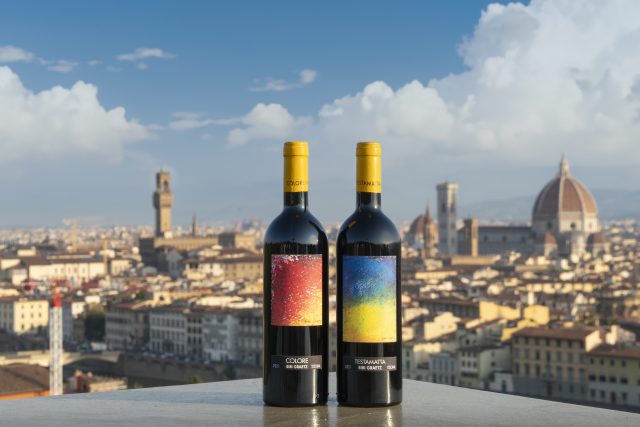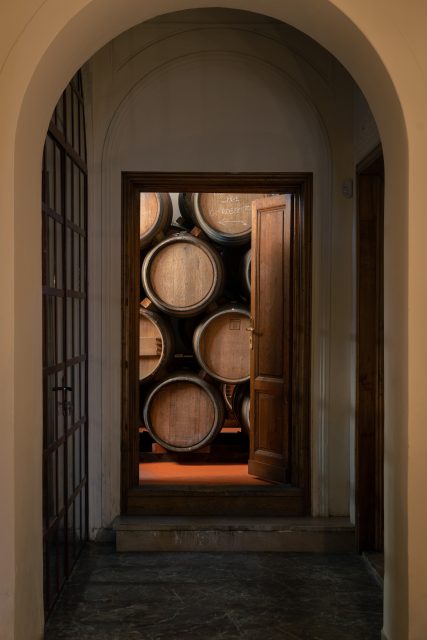This website uses cookies so that we can provide you with the best user experience possible. Cookie information is stored in your browser and performs functions such as recognising you when you return to our website and helping our team to understand which sections of the website you find most interesting and useful.
Bibi Graetz and the path to elegance
Bibi Graetz may be celebrated for cult red wines such as Testamatta and Colore, but a special white wine location – the island of Giglio – has had a significant influence on his winemaking philosophy, as Richard Woodard discovers…

“When I started doing my red wines, I immediately went to the island of Giglio to make white wines.” If Bibi Graetz’ early winemaking approach appears counter-intuitive, there are a couple of extra-curricular reasons for him to leave the Tuscan hills for a rocky isle off the Tuscan coast.
First of all, it was a second home. “We went there for three months a year for the first 18 years of my life,” says Graetz. “We were island guys. Then my father bought a sailboat and we left the island for 15 years, and went sailing around the Mediterranean coasts.”
And the second reason? “Two things I love: skiing and water. I was going to be stuck in the middle of the mountains near Florence – no snow, no water. So I went back to the island.”
But Giglio is also wine country. When Graetz was small, there were “hundreds” of small farms and wineries scattered across the island; when he returned in 2000, at the age of 33, there were “about 60” men, many pensioners, still working the vines there.
Graetz found they had a certain routine… 6-11am: work; then lunch, sleep, play cards, and pass from cellar to cellar getting slowly drunk – every day of the year. Beyond questionable lifestyle choices, he discovered something else: “They were convinced that the wines of the island were the best wines of the world – no argument,” Graetz says. “Some of the wines were very good, some were terrible, and you couldn’t spit any of them. Some wines were just extraordinary: a colour like Coca-Cola, with lots of oxidation.”

The pre-eminent grape was Ansonica (aka Inzolia), a thick-skinned, not very aromatic variety transformed by Giglio’s terraced vineyards and rocky/sandy soils. Graetz’ top white wines – Testamatta Bianco and Colore Bianco – remain 100% Giglio Ansonica from vines of up to a century old.
While neither remotely resembles Coca-Cola, they are robust, structured wines of a defined character. The name Giglio is derived from the Greek for “goat”, which Graetz feels is apt. “I like to say that this wine is a bit like a goat – it’s stubborn, it really hits you like a goat hits you.”
Giglio did more than offer Graetz a source of top-quality white wine. “Those old guys gave me the strength to say: ‘I didn’t study oenology, but I can allow myself to drop the winemaker and just do everything myself. If these guys can do fantastic wines when they’re on their pension, then as a 35-year-old putting all my energy in night and day, I can do something.”
Graetz ended his association with consultant Alberto Antonini – “Alberto is a friend, he is a great taster and winemaker, but … I couldn’t have someone else having their name on my wine – that was a problem for myself” – but it also exerted an influence on his red wines back in Fiesole.
“In 2000, when I started, it was all about concentration, super concentration, the more the better, 300% new oak,” says Graetz. “We were dropping fruit in the field, doing a drastic green harvest. So the wines were really blockbusters, super, super-concentrated. I realised quite soon that I was not so into that. Another reason why I decided to stop working with a winemaker, because they were always looking for concentration.”

If there was a tipping-point, it was the challenging 2009 vintage, when June rains caused the grapes to swell (as in 2019 and this year), followed by the “hyper-concentrated” 2010. While Graetz’ 2010 Testamatta and Colore reds attracted glowing reviews and high scores, the 2009s had a more lukewarm critical reception.
“I was going around the world, from Tromsø to Chicago, and I was tasting these wines with people from restaurants,” Graetz recalls. “They would say: ‘2009? Nice wine. 2010? Incredible vintage! Incredible scores! Now give me two cases of 2009.’
“I thought: ‘We have this completely wrong here. People don’t care about this concentration – they want to pair this wine with food.’ So I got a big smack in the face. I went back to my cellar and said: ‘Guys, we need to change things here.’”
Graetz told his team to stop cutting the shoots of the Sangiovese (a measure designed to boost concentration) – which he says led his agronomist to “freak out” and quit after six years. “Now everywhere in Tuscany, in Italy, there’s this trend of not cutting the shoots, letting the shoots grow. I was looking at the island of Giglio.”
The first wines that, in Graetz’ words, “got the point” in terms of elegance were the 2015s; in 2019, another difficult year brought a further step on the path away from concentration. Then came 2020, first of a trio of hot years.
“So, in 2020, I pushed it even further,” he says. For the first time, Testamatta’s fruit came only from northern slopes – save one high-altitude, windy vineyard at 420m. “When I tasted the wine, I was shocked. How did we manage to make such a wine?”
Testamatta 2020 divided opinion: some high scores, some low. In 2021, some of the lighter wines were removed, some southern slopes came back into the blend. “I was a bit scared by the remarks on the 2020,” Graetz admits. “I thought: ‘Maybe I need to take it easy a bit and take things a bit more slowly.’”
But he hasn’t changed his core philosophy. “To make a structured wine [in 2020, 2021 and 2022] is the easiest thing in the world, because of the heat. It’s much harder to make a transparent, elegant wine … To make a wine that’s 100% from northern slopes, that’s very unique. That’s definitely what’s going to be the future of Testamatta.”
The future of Graetz is also centred, unusually for him, on land he actually owns – an 80-hectare, 600m altitude plot with an “incredible microclimate” that he bought for €360,000 in a deal that also included 10 cows. Ten hectares are already planted, the vines in an amphitheatre looking down on the Graetz HQ in Fiesole, with Florence beyond.
Graetz is planting Sangiovese, but thinks the site has “great potential” for white wines too – which brings us back to Giglio. Here Graetz now owns 4ha of vineyards, and has planted another 6ha. “When I started, there was only one winery on Giglio,” he says. “Now there are 12, so I hope that in a few years there are going to be 58 wineries.
“The vineyards going from zero to 300m from the water, the dry stone terraces – it’s really something special. It’s breathtaking.”
Bibi Graetz has joined forces with Hedonism Wines to create a vault exclusively devoted to his wines at the Mayfair store – housing what is claimed to be the most complete collection of Bibi Graetz wines in London.
Bibi Graetz’ latest top-end releases – Testamatta Bianco 2022, Colore Bianco 2022, Testamatta 2021 and Colore 2021 – are available from wine merchants, via La Place de Bordeaux.

